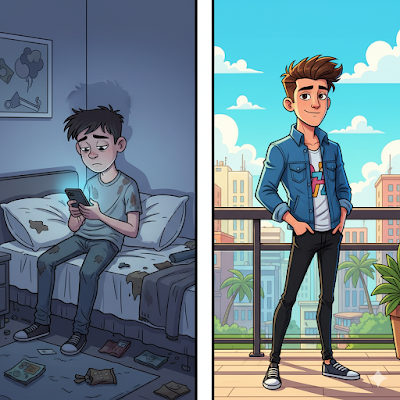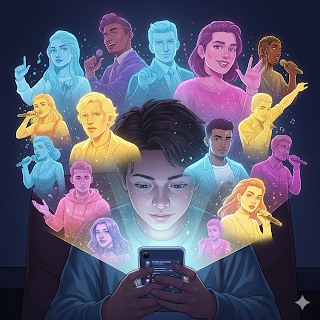Why We Scroll Social Media: The Comfort of Mindless Scrolling
Why People Scroll on Social Media
Last night, I found myself in one of those moments that every writer dreads — rejection. An organization turned down my latest article idea, citing “low-value citations.”
Instead of letting despair take over, I rolled up my sleeves, went through every line, and made a list of things to fix. But underneath that determination, a heavy knot of disappointment lingered. I just wasn’t ready to face it.
So, like many of us do when emotions start to feel overwhelming, I scrolled through social media. I grabbed my phone and plunged into the endless feed on Facebook. An hour later, I blinked, surprised at how much time had slipped away — and at the numbing calm that had quietly wrapped around me.
This wasn’t the first time scrolling had become my escape from pain. I remember a time after a heated argument between my parents when my emotions were a mess — anger, sadness, longing — all teetering on the edge of tears. Instead of confronting those feelings, I reached for my phone. By the end, the storm inside had quieted. I felt numb. Not healed. Not connected. Just… empty.
Related: Placebo Effect
Disclaimer
This article shares insights from personal experience and psychological research. It should not replace professional mental health advice or treatment.
If you’re feeling overwhelmed by emotions, anxiety, or depression, please reach out to a qualified mental health professional for support.
So why do we turn to our phones when our hearts hurt — and what does it say about us?
I conducted a survey in October 2025 on people in my circle. It had a simple question, “Do you scroll mindlessly on your phone?“.
Stats were not shocking as I have seen people drawn into their mobiles of subways, malls, restaurants — everywhere. About 85% admitted to aimless scrolling while rest of 15% said they don’t use their phones unless necessary. Some also asked for the solution as they had never been asked such a question that actually addressed the issue.
Mindless Scrolling and Dopamine: Why We Can’t Stop Scrolling Social Media
Psychologists recognize this pattern as emotional avoidance. Dr. Susan Koven, a clinical psychologist, puts it simply:
“Scrolling can become a coping mechanism that offers temporary relief from emotional pain. It distracts from feelings like anxiety, rejection, or loneliness — but it’s a short-term fix.”
Our brains are wired to seek pleasure and avoid pain. When we scroll, dopamine floods the brain — giving brief bursts of pleasure that pull us deeper into the feed.
Dr. Anna Lembke, author of Dopamine Nation, explains:
“Social media platforms exploit the brain’s reward system through variable rewards — likes, comments, and notifications — that trigger dopamine surges. It’s addictive, but ultimately hollow.”
That cheap dopamine might lift your mood, but it doesn’t heal the hurt underneath — the sting of rejection or the ache of loneliness remains.
Mindless Scrolling: Why It’s Bad for Your Brain
Social media promises connection, but often delivers isolation instead.
A 2017 American Journal of Preventive Medicine study found that people spending more than two hours daily on social media were more likely to feel socially isolated. Passive scrolling encourages shallow engagement instead of deep connection.
Dr. Sherry Turkle, author of Alone Together, highlights the irony:
“Technology allows us to be alone together. We’re connected, but not necessarily present. We have the illusion of companionship without the demands of friendship.”
That illusion feeds comparison and detachment — leaving us craving more content to fill the void.
Effects of Mindless Scrolling on Mental Health
The pattern of reacting to discomfort with distraction is a shared human story. The more we scroll to escape pain, the further we drift from ourselves and from authentic connection.
Dr. Koven warns:
“When we avoid uncomfortable emotions through digital distraction, we risk emotional fragmentation, where parts of ourselves are disconnected and unmet.”
That fragmentation weakens emotional resilience and leaves us more vulnerable to deeper feelings of isolation. The more I learned, the more I realized — scrolling isn’t the problem. It’s what we’re avoiding that truly hurts.
How to Stop Scrolling on Social Media: Break the Cycle
Breaking free starts with awareness and intention. Here are some techniques psychologists have recommended:
1. Mindful Scrolling
Before unlocking your phone, ask yourself: Why do I want to scroll right now?
This moment of awareness interrupts autopilot behavior. My personal experience is whenever I try to disrupt my autopilot, it’s just a matter of seconds where a lot of camouflaged emotions show up. I consider it an achievement to win over those and choose mindfulness over numbness.
2. Sit With Discomfort
Feelings like rejection or sadness aren’t enemies — they’re messages.
Dr. Brené Brown reminds us:
3. Try a Digital Detox
Brief breaks from social media reduce anxiety and boost mood. It helps reset your brain’s reward system. Being exposed to endless feed promoting perfection, the pressure do outplay everyone else comes real. So, detoxing your mind from homeless thoughts brings mental harmony and organization of actions.
4. Seek Depth Over Breadth
Use digital platforms to connect meaningfully — not just to consume. Engage in real conversations. Listen to people actually, not just hear. Try to speak, refrain from talking. And most importantly be present when in conversations which is helpful in reducing mind fog.
5. Shake Your Head:
Whenever going into an autopilot mode, gently shake your head left to right or quiver or pinch your hand. Your body will consider the shake as cue to return to its normal functioning. I discovered this habit as a child and later came to know that it’s supported by neuroscience.
The Power of Presence: Channel Your Inner Puma and Leo
Our puma spirit represents grounded strength and stillness. The Leo within us calls for courage — the bravery to confront discomfort instead of escaping it.
Scrolling isn’t inherently bad; it’s like fire — it can warm or burn, depending on how we use it.
Next time you feel the urge to scroll, pause and ask: What am I trying to escape?
Related: Self-Perception Psychology
Conclusion: Scroll With Intention
In a world designed to distract you, choosing to be present is radical. It’s about facing your truth and connecting deeply.
So when your thumb hovers over that screen — remember, you have the power to break the cycle.
Scroll with purpose. Feel with purpose. Live with purpose.
Because real comfort doesn’t come from numbing the chaos — it comes from learning to dance with it.
A Call to Action: Take Back Your Attention
Scrolling will always be there — endless, tempting, and easy. But your attention? That’s precious.
💡 Try this challenge:
1. Limit social media time to 1 hour per day. Stick through it.
2. Journal when you feel the urge to scroll. Don’t be lazy or ignore the urge.
3. Replace doomscrolling with a walk, music, or a real conversation.
Related: Why Gen Z laughs through Stress
The power to reconnect with yourself and others lies in those small acts of independency and mindful choices. Start reclaiming your attention today. Readanica is here cheering for you!









